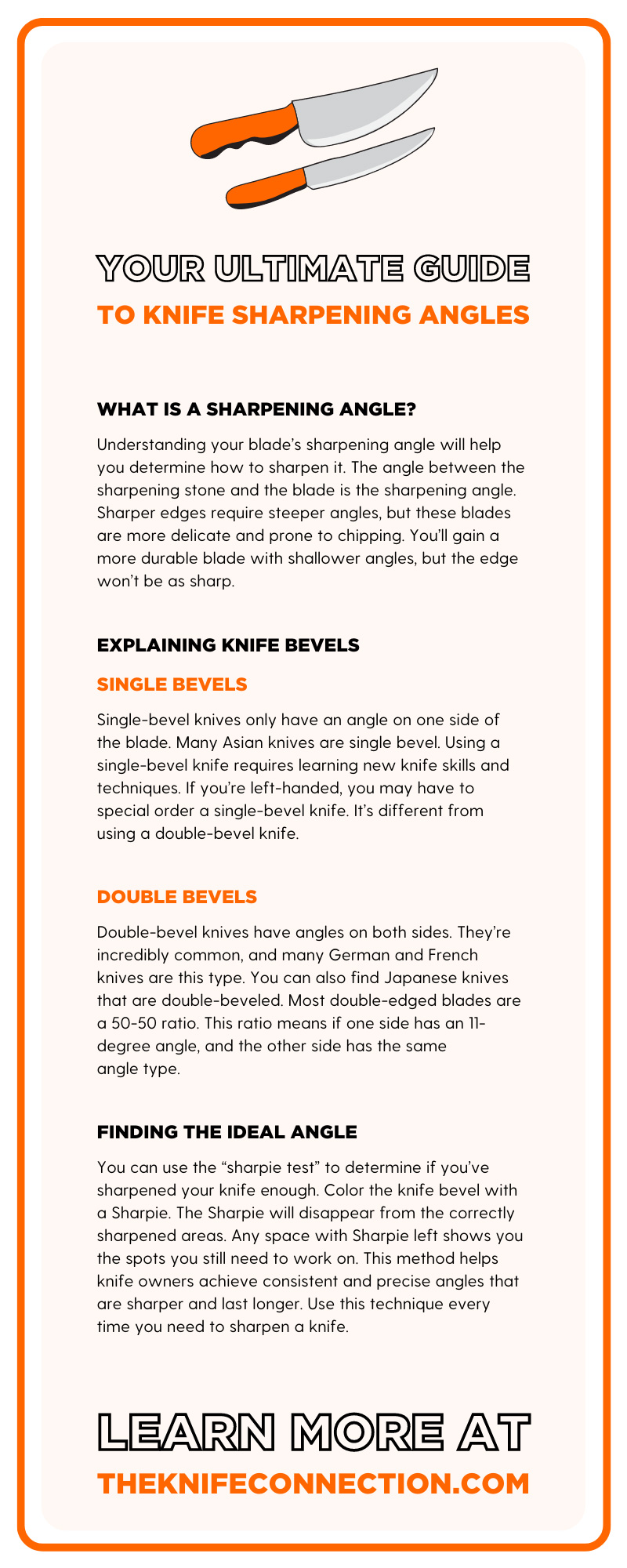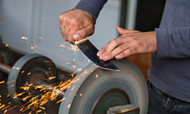Your Ultimate Guide to Knife Sharpening Angles
May 22 2023 - 8:05
The angle is one of the most important things to remember when sharpening your knife’s blade. It all depends on the type of knife, the steel, and the edge. How do you know which angle is best for your knife? Continue reading to discover the ultimate guide to knife sharpening angles. It will keep your knife in good working condition.
What Is a Sharpening Angle?
Understanding your blade’s sharpening angle will help you determine how to sharpen it. The angle between the sharpening stone and the blade is the sharpening angle. Sharper edges require steeper angles, but these blades are more delicate and prone to chipping. You’ll gain a more durable blade with shallower angles, but the edge won’t be as sharp.
The Importance of Sharpening
Sharpening your knives is important to maintain their longevity and performance. The challenging part is understanding the best angle to sharpen the blades.
Dull knives lead to more injuries with slippage. You have to press down harder with a dull blade, making it easier to slip and cut yourself. A sharp edge will enable you to cut food, wood, and other items easily.
Explaining Knife Bevels
The knife bevel is one of the essential aspects that determine a knife’s strength, use, durability, and sharpness. It’s the shape and ground angle of the blade’s edge that dictate the type of knife you have.
Knives come in double or single bevels. You’ll hear them commonly referred to as single-edged blades or double-edged blades.
Single Bevels
Single-bevel knives only have an angle on one side of the blade. Many Asian knives are single bevel. Using a single-bevel knife requires learning new knife skills and techniques. If you’re left-handed, you may have to special order a single-bevel knife. It’s different from using a double-bevel knife. This bevel type can create thinner cuts. Many sushi chefs love to use it on vegetables and fish.
Double Bevels
Double-bevel knives have angles on both sides. They’re incredibly common, and many German and French knives are this type. You can also find Japanese knives that are double-beveled.
Most double-edged blades are a 50-50 ratio. This ratio means if one side has an 11-degree angle, and the other side has the same angle type. It creates a total blade angle of 22 degrees. Most traditional Western knives have slightly larger angles than Asian knives.
Under 10-Degree Angles
The lowest angles are perfect for cutting soft materials. The edges don’t have to work hard, so the knife can maintain a lower grade without edge failure or damage. Straight-edge razors are where you’ll usually see the lowest angles. A razor won’t ever see use that could damage the blade. Typically, a razor will have a seven to eight-degree angle.
Water stones are the most effective tools to sharpen a straight razor. Avoid using anything coarser than 1,000 grit with these delicate edges.
10- to 15-Degree Angles
Ten- to fifteen-degree angles are fine and delicate. You won’t find this angle on a knife for chopping, but it could handle slicing meats or other soft items. Anything harder could damage the blade. The lower bevel provides an incredibly smooth cutting action.
Japanese knives with 15-degree angles have become more popular among knife enthusiasts. They use quality steel that can withstand harder materials.
Experts recommend using sharpening stones to sharpen 10- to 15-degree angle blades. Use water stones if you’re sharpening Japanese knives.
15- to 17-Degree Angles
You’ll commonly find 15- to 17-degree angles on Japanese knives, although they’ve become more popular among European and American cutlery. Together they’ll create a 30- to 34-degree angle, and many experts say you shouldn’t go lower than that.
There are different sharpeners you can use to sharpen these edges. Guided systems, powered sharpeners, and sharpening stones will work perfectly.
17- to 22-Degree Angles
Most knives you use every day will have 17- to 22-degree angles. You’ll find outdoor, kitchen, and pocket knives in this angle range. Many Western knives are available with 20-degree angles, while most Japanese knives will have a 17-degree angle.
Knives with these angles are incredibly durable and can cut well. They have a good tradeoff between durability and sharpness.
22- to 30-Degree Angles
Many pocket and hunting knives are available with 22- to 30-degree angles. Some knife enthusiasts consider this selection of knives to be the most durable. Many knives don’t need a knife blade cut to this angle range because they’ll only cut through softer materials. But they don’t need the durability these angles provide. Hunting knives require durable blades due to the stress they endure.
Over 30-Degree Angles
Only one word comes to mind regarding any knife with a blade angle over 30 degrees—durable. It won’t have the best cutting ability because it needs more force to make the cuts. You’ll mainly find edged tools such as axes, machetes, and cleavers with a 30-degree angle or more. Most other knives won’t benefit from it.
Finding the Ideal Angle
Our world loves finding the best steel for knives. But the reality is heat treatment and geometry are responsible for a knife’s cutting performance.
What is the main use of your knife? Is it for cutting up vegetables? Filleting fish? Will you use it to skin game from a hunting trip? Answering these questions will help you decide the best angle for your knife.
You can use the “sharpie test” to determine if you’ve sharpened your knife enough. Color the knife bevel with a Sharpie. The Sharpie will disappear from the correctly sharpened areas. Any space with Sharpie left shows you the spots you still need to work on. This method helps knife owners achieve consistent and precise angles that are sharper and last longer. Use this technique every time you need to sharpen a knife.
Now that you have the ultimate guide to knife sharpening angles, you can find and care for quality knives. The Knife Connection carries a vast selection of everyday carry knives perfect to use in everyday situations. We’ve curated a list of premium tactical folding knives and durable fixed-blade models for our customers to browse. Browse our collection to find the right one for you.

